Top 14 Religious Tourist Attractions in Iran
Have you ever dreamt of a vacation that feeds your soul as much as your Instagram? Iran might surprise you!
This historic country isn't just about ancient ruins (although those are pretty amazing too). Iran boasts incredible religious sites that are architectural wonders, peaceful havens, and hold deep significance for many faiths.
Ready to explore a different side of Iran? Here are some of Iran's most significant religious sites.
Top 14 Religious Sites in Iran
- Imam Reza Holy Shrine, Mashhad
- Fatima Masumeh Shrine, Qom
- Shah Cheragh Shrine, Shiraz
- Vank Cathedral, Isfahan
- Towers of Silence, Yazd
- Atash Behram, Yazd
- Jameh Mosque of Isfahan, Isfahan
- Sheikh Lotfollah Mosque, Isfahan
- Shah Mosque (Royal Mosque), Isfahan
- Jameh Mosque of Yazd, Yazd
- Amir Chakhmaq Mosque, Yazd
- Nasir al-Mulk Mosque, Fars
- Saint Mary Church, Urmia
- Temple of Anahita, Kangavar
1. Imam Reza Holy Shrine, Mashhad
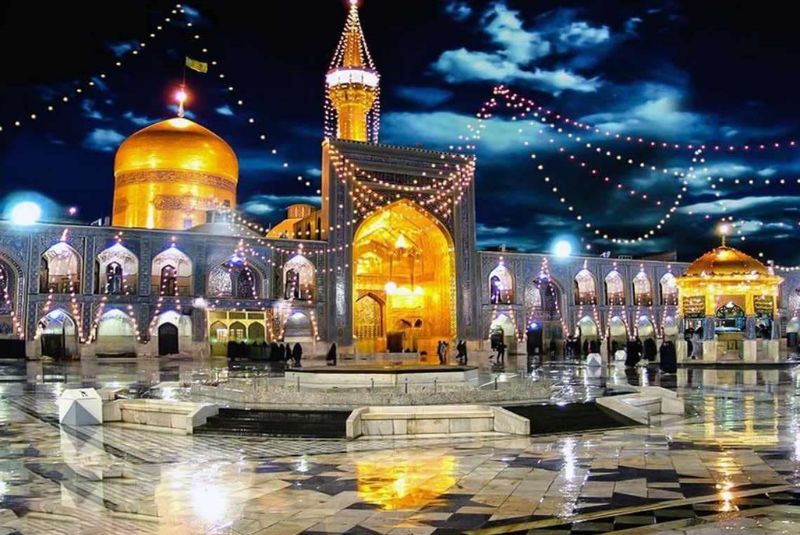
The Imam Reza Holy Shrine, located in Mashhad, Iran, is a sprawling complex centered around the tomb of Imam Ali al-Rida, the eighth Imam in Twelver Shi'ism. Mashhad itself developed around the shrine over centuries, transforming from a small village to a major pilgrimage center.
Construction of the shrine began in the 9th century, and the complex has continuously grown over nearly a millennium. The resulting architecture reflects various artistic styles and periods. The most prominent feature is the golden dome, which enshrines the Imam's tomb. Visitors can also explore the Goharshad Mosque, a museum, a library, and several courtyards.
As the largest mosque in the world by area, the Imam Reza Shrine is a significant pilgrimage destination, attracting millions of visitors annually, particularly Shia Muslims. If you plan to visit, respectful clothing that covers arms and legs is recommended.
| Check out our Mashhad tour packages to find the one that suits you best.
2. Fatima Masumeh Shrine, Qom
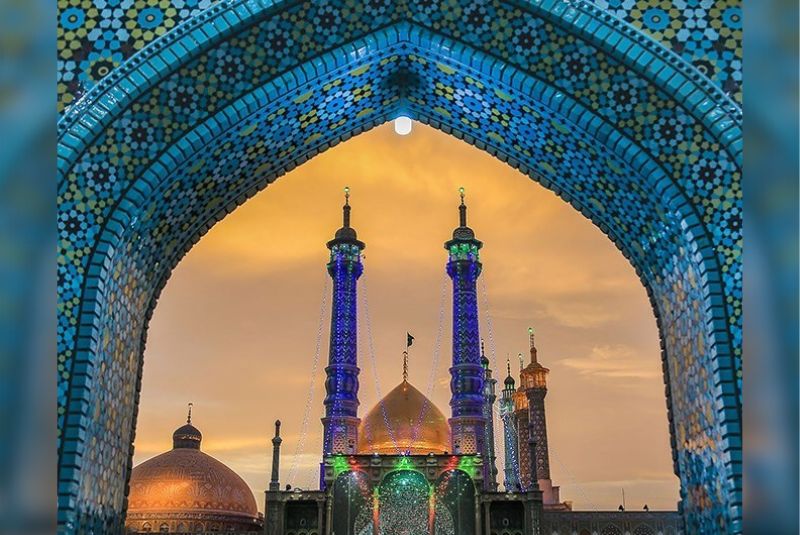
Qom is often referred to as the "second holiest city in Iran" after Mashhad, which houses the Imam Reza Shrine. Qom itself has a rich history, but its rise to prominence is deeply intertwined with the shrine of Hazrat Masoumeh.
The Fatima Masumeh Shrine is a burial complex situated in Qom, Iran. It enshrines Fatima Masumeh, the sister of Imam Reza, the eighth Imam of Twelver Shi'ism. Due to her lineage, Fatima Masumeh is revered as a saint in Shia Islam, making her shrine one of the most important in Iran.
The shrine's origins date back to the 9th century AD, following the death and burial of Fatima Masumeh. The architectural style reflects a long history of expansions and renovations. The prominent feature is the golden dome, a characteristic element of Shia shrines. The complex also includes courtyards, a sanctuary, and a museum. The shrine is a significant pilgrimage destination, attracting millions of visitors annually, particularly Shia Muslims.
| Discover: Top 16 Most Beautiful Mosques in Iran
3. Shah Cheragh Shrine, Shiraz
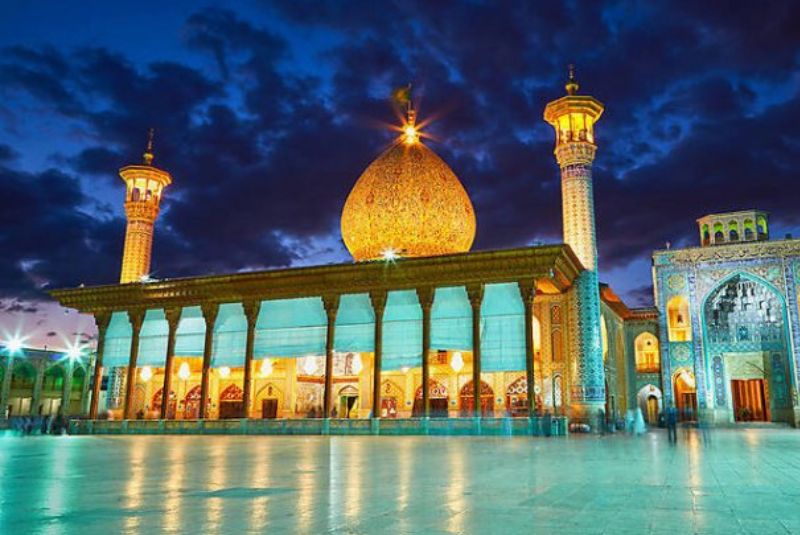
Unlike the quiet sanctity of the Fatima Masumeh Shrine, the Shah Cheragh Shrine in Shiraz, Iran, announces its presence with a dazzling display of light and color. This 12th-century funerary complex is much more than a pilgrimage site; it's a captivating architectural masterpiece. Enshrined here are the brothers Ahmad ibn Musa al-Kazim and his brother Muhammad ibn Musa, sons of the seventh Imam in Twelver Shi'ism, Musa al-Kazim.
The shrine's very name, "Shah Cheragh," translates to "King of Light," hinting at its most striking feature: the extensive use of mirrorwork. The Qajar-era dome, a relatively recent addition, shimmers with a kaleidoscope of colors, reflecting sunlight and casting an ethereal glow on the interior. Intricate floral and geometric patterns dance across the walls, creating a mesmerizing spectacle that draws visitors in with its visual opulence.
This focus on visual splendor sets the Shah Cheragh Shrine apart from other holy sites. While its pilgrimage significance is undeniable, the artistic brilliance takes center stage, offering a captivating experience for all who enter.
| Explore Eavar's Shiraz tour packages.
4. Vank Cathedral, Isfahan
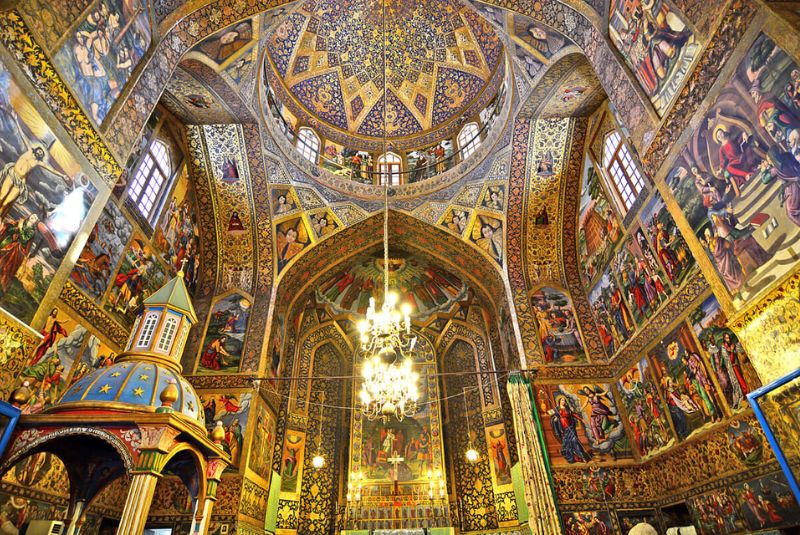
The Vank Cathedral, also known as the Holy Savior Cathedral, is an Armenian Apostolic church situated in Isfahan, Iran. Isfahan, a city steeped in history, flourished as the capital of the Safavid Empire (1501-1736). During this period, Shah Abbas I the Great relocated a large Armenian Christian community to Isfahan, establishing a new district known as New Julfa. Vank Cathedral emerged from this vibrant Armenian enclave in 1664.
The cathedral's architectural style reflects a blend of Armenian and Safavid influences. The exterior is built primarily with brick, following the traditional Iranian aesthetic, while the interior boasts frescoes and oil paintings, a hallmark of Armenian church decoration. Vank Cathedral is a significant landmark for the Armenian Christian community in Iran and is recognized for its unique architectural style.
| Visit the most touristic city of Iran with our Isfahan tours.
5. Towers of Silence, Yazd
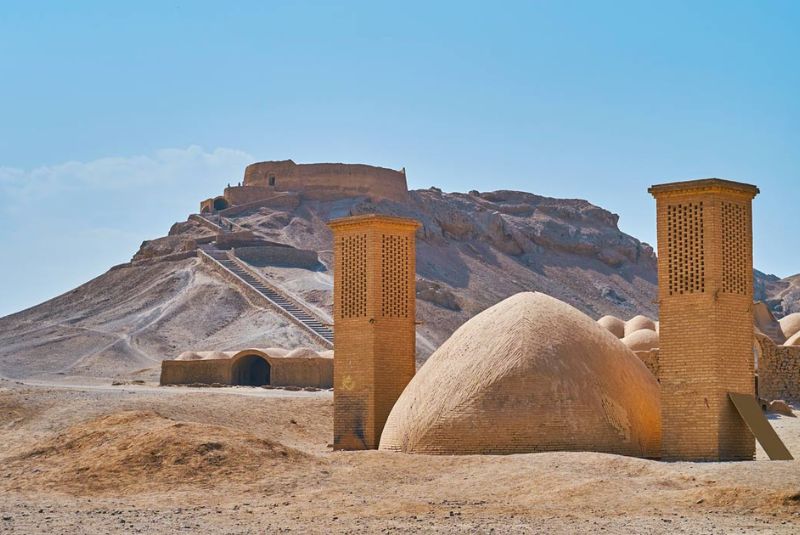
The Towers of Silence, also known as the Dakhmeh of Zoroastrians, are two circular, raised funerary structures located on a hill outside the Iranian city of Yazd. Yazd has a long history as a center of Zoroastrianism, one of the world's oldest religions. Zoroastrian beliefs emphasize the purity of earth, fire, and water, and traditional burial practices seen as polluting these elements.
The Towers of Silence were used by Zoroastrians for the ritual of sky burial until the mid-20th century. Corpses were placed on the open-air platforms of the towers, where carrion birds would consume the flesh. The remaining bones would decompose in an ossuary below. Following a change in regulations and the decline of the practice, the towers are no longer used for this purpose. However, they remain a significant landmark and cultural heritage site for Yazd's Zoroastrian community.
| Check out Eavar's Yazd tour packages.
6. Atash Behram, Yazd
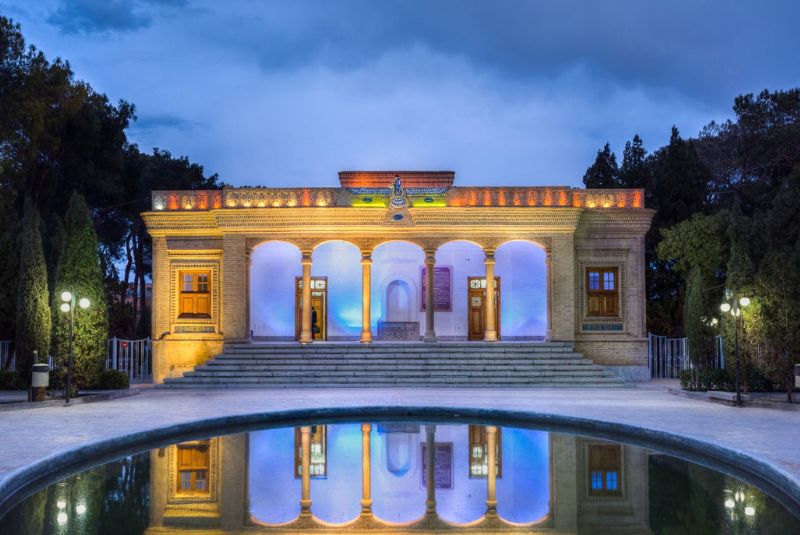
One of the most significant landmarks in Yazd is the Atash Behram (Atashgah), also known as the Yazd Fire Temple.
According to inscriptions within the temple, the Atash Behram enshrines a fire believed to have been burning continuously since 470 AD. Zoroastrianism reveres fire as a symbol of purity and divinity, and the Atash Behram houses a fire of the highest grade, called an Atash Bahram. Maintaining this fire requires meticulous care and involves a complex ritual of combining flames from 16 different sources.
Construction of the current temple structure dates to the 1930s, funded by the Parsi Zoroastrian community of India. The building exemplifies traditional Iranian architecture, with its brick facade and geometric patterns. Visitors can observe Zoroastrian priests performing rituals and worshippers offering prayers at designated times. The Atash Behram remains a powerful symbol of faith and a significant pilgrimage site for Zoroastrians around the world.
| Suggestion: Faravahar Symbol in Zoroastrianism
7. Jameh Mosque, Isfahan

The Jameh Mosque of Isfahan, also known as the Friday Mosque or Atiq Mosque, is a historic congregational mosque (Jameh) located in the heart of Isfahan, Iran. This sprawling complex is a UNESCO World Heritage Site and a testament to the city's rich architectural heritage. Isfahan flourished as a major political and cultural center for centuries, and the Jameh Mosque reflects this evolution through its diverse architectural styles and ongoing development.
The mosque's origins date back to the 8th century AD, with the initial construction commissioned by the Abbasid caliph Al-Mansur. However, the Jameh Mosque is not a static monument; it has undergone numerous expansions, renovations, and additions throughout its history. Seljuk sultans, Ilkhanid rulers, Timurid emirs, and Safavid shahs all contributed to the mosque's current form. This layering of architectural styles creates a fascinating display, with elements of Abbasid, Seljuk, Timurid, and Safavid eras all present within the complex.
The Jameh Mosque is renowned for its four-iwan layout, a signature feature of Seljuk architecture. Each iwan, a vaulted entrance hall, opens onto a central courtyard, creating a sense of symmetry and grandeur. The mosque also boasts a distinctive double-shelled ribbed dome, an innovation attributed to the Seljuks and a hallmark of Isfahan's architectural style. It continues to be a focal point for Isfahan's Muslim community and a captivating attraction for visitors.
8. Sheikh Lotfollah Mosque, Isfahan
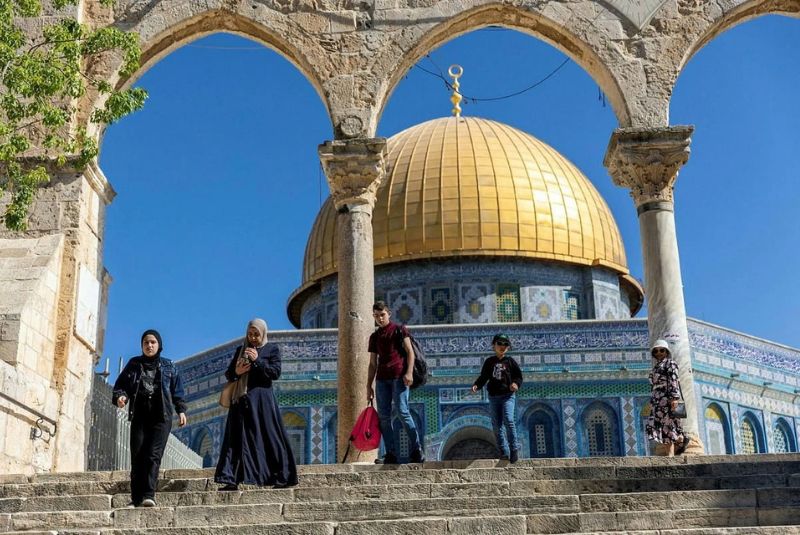
The Sheikh Lotfollah Mosque is located on the eastern side of Naqsh-e Jahan Square in Isfahan, Iran. Construction began in 1603 during the reign of Shah Abbas I the Great of the Safavid dynasty. The mosque is named after Sheikh Lotfollah Maysi, a prominent scholar and father-in-law to Shah Abbas, though his exact role in the mosque's construction is unclear.
Unlike some larger mosques, the Sheikh Lotfollah Mosque is a smaller structure and may have been intended as a private sanctuary for the royal family or a women's mosque. The exterior is relatively modest, built with brick and featuring a single dome. However, the interior is renowned for its exquisite seven-color tilework, intricate geometric and floral patterns, and focus on light and color. These elements exemplify the refined aesthetic of Safavid era architecture. The Sheikh Lotfollah Mosque is a UNESCO World Heritage Site and a significant landmark in Isfahan.
| Related: Top 10 Isfahan Mosques You Should Visit
9. Shah Mosque (Royal Mosque), Isfahan
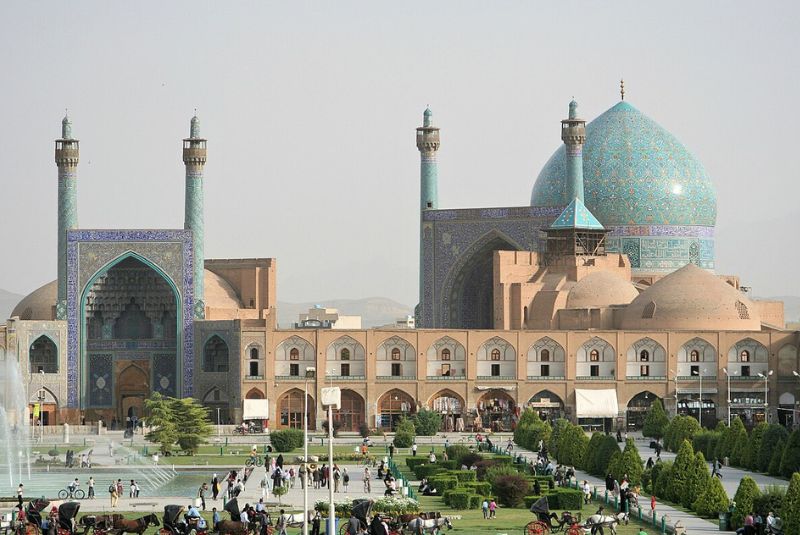
The Shah Mosque (Persian: مسجد شاه), also known as the Royal Mosque or Imam Mosque, is a mosque situated on the south side of Naqsh-e Jahan Square in Isfahan, Iran. Constructed during the reign of Shah Abbas I the Great (1588-1629) of the Safavid dynasty, it is considered a masterpiece of Persian architecture in the Islamic era.
Building began in 1611 and was completed around 1630 under Shah Abbas's successor, Shah Safi. The Shah Mosque was envisioned as a grand architectural statement, solidifying the Safavids' power and prestige. The monumental entrance portal (iwan) directly faces the northern arcade of the square, creating a powerful visual axis.
The mosque's architectural style blends grandeur with intricate details. The vast domed sanctuary is the largest in Isfahan, while the four iwans flanking the courtyard are adorned with vibrant tilework and calligraphy. The mosque's significance extends beyond its architectural beauty. Shah Abbas intended it to be a religious and political center, housing religious schools and strategically positioned near the royal palace complex.
Today, the Shah Mosque (Royal Mosque) remains a prominent landmark in Isfahan, attracting millions of visitors annually. It is registered, along with Naqsh-e Jahan Square, as a UNESCO World Heritage Site.
| Discover: Monar Jonban | The Mystery of Iran's Shaking Minarets
10. Jameh Mosque of Yazd
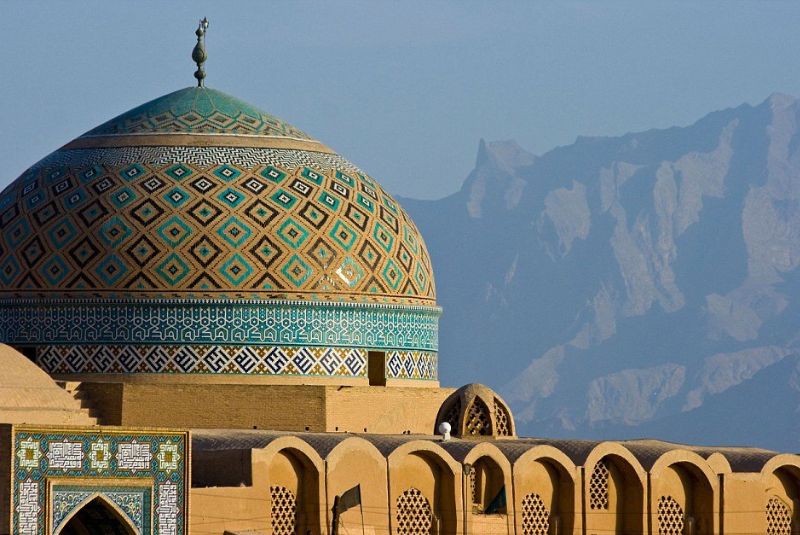
The Jameh Mosque of Yazd (Persian: مسجد جامع یزد), also known as the Friday Mosque, is the grand congregational mosque (Jameh) of Yazd city, Iran. Located in the heart of the old city, the mosque is a prominent landmark and a significant monument of Iranian Islamic architecture. Its depiction graces the obverse of the Iranian 200 rials banknote.
The origins of the Jameh Mosque date back to the 12th century, when construction began on the site of a former Sassanid fire temple. However, the current structure primarily reflects later expansions and renovations. Major building campaigns occurred in the 14th and 15th centuries, with further additions throughout the centuries. This layered development resulted in a unique architectural style that blends elements from various eras, showcasing the evolution of mosque design in Yazd.
The mosque is renowned for its towering twin minarets, considered the tallest in Iran at 52 meters high. These elegant minarets, built during the Safavid era (1501-1736), are decorated with intricate tilework patterns. Beyond the minarets, the Jameh Mosque boasts a vast central courtyard, surrounded by prayer halls and adorned with intricate tilework and plasterwork.
Read more: Persian Garden | A Piece of Paradise in Iran
11. Amir Chakhmaq Complex, Yazd

The Amir Chakhmaq Complex is a prominent structure in Yazd, Iran, noted for its symmetrical sunken alcoves. It is a mosque located on a square of the same name. The complex also contains a caravanserai, a tekyeh (a place to hold religious mourning rituals), a bathhouse, a cold water well, and a confectionery.
Construction of the mosque, commissioned by Jalal ed-Din Amir Chakhmaq Shami, governor of Yazd under Shahrukh Mirza, began in 1424 and was completed in 1438. During the era of Fath Ali Shah, Hossein Attar added a part to its shabestan (basement prayer hall) and restored some parts of the mosque.
The complex is a significant landmark in Yazd and a popular tourist destination. The mosque itself is still functional, while the caravanserai and other parts of the complex now house shops and cultural exhibits.
12. Nasir al-Mulk Mosque, Fars

The Nasir al-Mulk Mosque (Persian: مسجد نصیر الملک), also known as the Pink Mosque or Mosque of Colors, is a traditional mosque located in Shiraz, Iran. Construction began in 1876 and was completed in 1888 by Mirza Hassan Ali Khan Nasir al-Mulk, a Qajar nobleman.
The mosque is renowned for its extensive use of colored glass in its facade. Sunlight passing through the stained glass creates a dazzling display of colors on the interior walls and carpets, contributing to the mosque's nickname, the "Pink Mosque" due to the abundance of rose-colored glass. The mosque also features intricate tilework and mirrorwork, with floral and geometric patterns decorating the walls. The Nasir al-Mulk Mosque is a popular tourist destination and a significant example of Qajar era religious architecture. It’s one of the most beautiful religious tourist attractions in Iran.
13. Saint Mary Church, Urmia
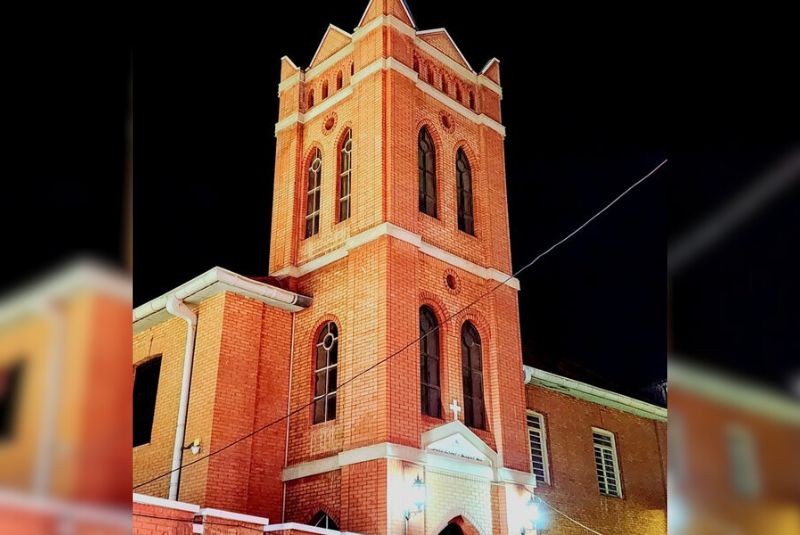
The Saint Mary Church, also known as Naneh Maryam Church, is an ancient Assyrian church located in the city of Urmia, West Azerbaijan Province, Iran. Claimed by some historians to be the second-oldest church in Christendom after the Church of the Nativity in Bethlehem, the church's origins remain debated.
Possible origins include construction on the tomb of the magi or conversion from a Zoroastrian fire temple in the early centuries AD. Archaeological evidence suggests a construction date during the Sasanian period (224–651 AD). The architectural style reflects this long history, blending Sasanian and Arsacid (247 BC – 224 AD) influences. The church features a traditional layout with a small entrance leading down to the main hall, an altar, several chambers, and a vestibule.
Saint Mary Church has had a turbulent past, briefly serving as a Russian Orthodox church during World War I. Restored in the mid-20th century, it remains an active church and a significant pilgrimage site for Assyrian Christians. Despite the debate surrounding its exact age, Saint Mary Church is undoubtedly one of the oldest Christian structures in the world, holding historical and cultural significance for Urmia. During your trip to Iran, make sure to visit Saint Mary Church.
| Discover: Famous Churches in Iran
14. Temple of Anahita, Kangavar
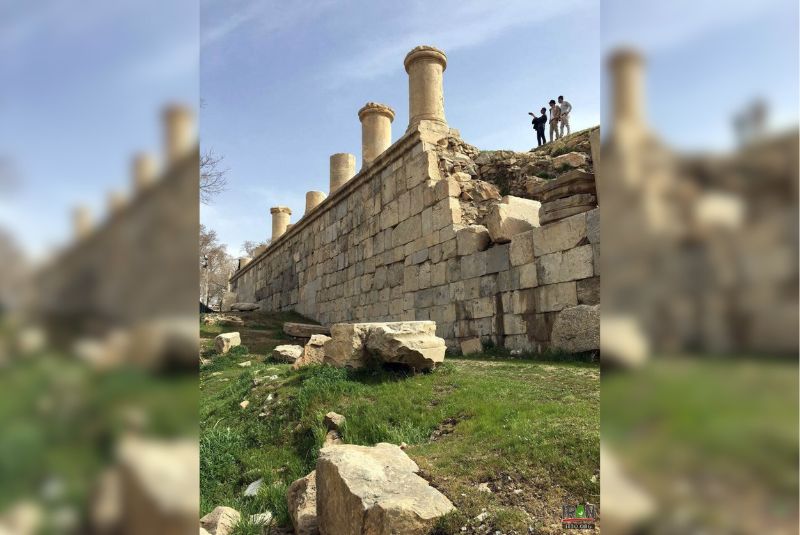
The Temple of Anahita, located in Kangavar, Kermanshah Province, Iran, is a significant archaeological site. This monument was dedicated to Anahita, an ancient Iranian goddess associated with water, fertility, and abundance.
The exact date of construction is debated, with estimates ranging from the Achaemenid period (550–330 BCE) to the Parthian period (247 BCE – 224 CE). The massive stone platform and foundations suggest an Achaemenid origin, while some decorative elements may be from Parthian or Sassanian (224–651 CE) additions.
The temple itself likely featured a central square structure with a hypostyle hall (a large, columned room). Water played a key role in Anahita's worship. An elaborate system of channels and pools channeled water from a nearby river to a central pond within the complex, showcasing the importance of water and the ingenuity of ancient engineers.
The Temple of Anahita, though in ruins, remains a UNESCO World Heritage Site and a major religious tourist attraction in iran. It offers valuable insights into the religious practices, architectural styles, and water management techniques of the ancient Iranian world.
Bottom Line
Our list of religious tourist attractions in Iran highlights structures that reflect the country's rich religious history and diversity. Iran welcomes you to experience the beauty and history held within these architectural wonders. Remember to dress modestly and be respectful when visiting these sacred places.
Share your story!
Comment below and let us know about your Experience.
Your story inspires others!


Comment
Leave a Comment